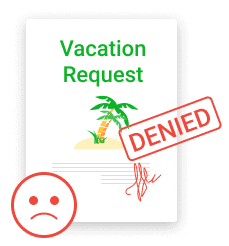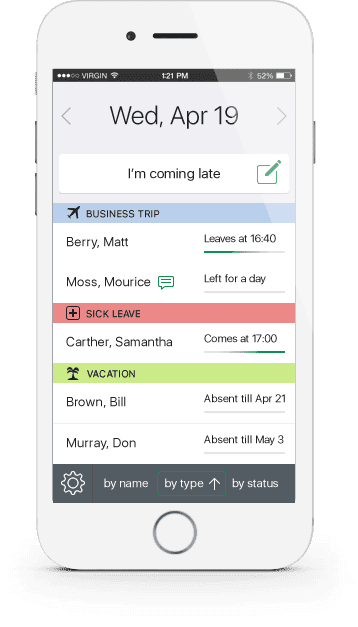Along with the end-of-the-year holiday season, summertime is officially the hardest period to keep your employees engaged in work. As the weather is getting nicer, staying indoors – either at home or in the office – becomes a tough challenge. Thus, many of your team members have their heads in the clouds more frequently with the approach of June, dreaming of all the lovely ways to spend the well-earned time off.
The vacation season often means a much quieter and less crowded workplace. It also means that you have to find an effective way to manage employees’ numerous leave requests and track their absences. The goal here is to let everyone on your team enjoy their share of carefree summer days while preventing business downtime and maintaining the optimal level of productivity.
That’s why you can’t get away without an intelligent online leave tracking system. Luckily for you, this article explains how to organize one in the best way possible and talks about the role of absence tracking in avoiding the heavy leave request traffic jam during the peak vacation season.
Key Staff Management Challenges During the Summertime
The 2020 vacation season was a drag. With most traveling destinations closed and strict social distancing rules imposed, we couldn’t leave our homes even on the finest of days off. But this year, we can hope for a wee bit more – though the largest part of the world will likely remain closed for travelers, domestic destinations are sure to make a hit.
Considering the previous year’s widespread vacation failures, people are eager to catch up with all the fun that summer travel has to offer. Therefore, a soon-to-come deluge of time off requests is a reasonable thing for managers to expect, and you definitely need to be on high alert of possible overlaps in employees’ vacation plans.
Conflicting and overlapping leave requests can turn into a nightmare for each stakeholder involved – HR managers, business owners, and time off requesters themselves:
- If you allow several employees to go on vacation within the same period, your business may experience a significant productivity drop. In severe instances, your company can even lose the ability to properly function while your essential employees are off work for the long term, and those in the office left to struggle with project delays, impaired collaboration, and poor communication.
- If you don’t let your team members take vacations simultaneously, time off overlaps mean that someone’s leave request is bound to be declined. And of course, there’s a high chance that a person with rejection at hand won’t be that pleased about it, especially if some grandiose vacation plans were made. In the meantime, dissatisfied employees are the creatures to beware of: they are the agents of chaos and serve the dark forces of gloom that disrupt team morale, instill distrust, and desolate the fertile grounds of productivity.

- Finally, overlapping leave requests are just too burdensome to deal with. At the minimum, they require replanning, rescheduling, and notifying of persons whose vacation plans were denied. So, to utilize your business resources more efficiently and show some appreciation for your team members’ time, try to reduce the occurrence of conflicting leave requests in the first place.
Here’s How to Do That in 5 Easy Steps
1. Develop an informative time off policy
A time off policy is the compilation of leave management rules enforced in a company. It explains:
- How employees’ time off balances are accrued,
- How many paid or unpaid days off are available to workers per year,
- How one is supposed to request a leave of absence,
- How much in advance a vacation should be scheduled,
- Who is responsible for the process of leave request approval,
- When a leave request may be rejected and why.
By clarifying all these points, a time off policy gives your employees a good understanding of what to expect when asking for days off on different occasions. This way, it addresses possible vacation conflicts even before they arise.
To help your workers better cope with possible leave rejections, the policy should also indicate how you will treat their time off requests and approve the coinciding ones. For example, you can prioritize them based on the “first come, first served” rule, employee seniority, history of previous leave requests, and so on.
2. Encourage long-term vacation planning
It’s easier to track and prevent conflicting leave requests when everyone schedules vacations in advance.
Of course, occasional and unplanned day off taking is impossible to avoid completely. After all, your staff members are not everlasting machines. And unlike robots, they do periodically need a short break to relax, manage personal matters, cope with stress or recover from sickness.
However, by encouraging your team to request longer-term leave periods aforehand, you will get rid of many unnecessary absence management pains, including continual time off rescheduling and leave request rejections. Early leave scheduling and approval also guarantee that employees’ vacation plans are to be realized in an intended way, without any revisions or improvised changes. So, make sure to let your staff members know about that too.
3. Adopt a self-service system for absence tracking
Employee self-service software allows your staff members to handle a variety of work-related issues without addressing the HR department or team managers directly. Using this software, they can:
- Review and edit important personal information
- Access organizational handbook and different policies
- Manage their time off balances and insurance plans
- Schedule vacation time and log days off
All the above and other similar tasks don’t have to be paper-based or overseen by HR representatives anymore. In fact, by letting your employees be in charge of them, you will save a lot of time for everyone, decrease administrative costs, and boost process efficiency considerably. It’s safe to say that self-service absence tracking software makes leave management much more enjoyable and satisfying for all parties involved.
4. Streamline leave request approval
Another way to reduce the occurrence of time off overlaps with finesse is by handling each leave request right after it’s received. If you still live in the pre-digital age and happen to manage a large team in the meantime, doing so is bound to be challenging, to say the least. But if you take full advantage of digitalization and don’t shy away from automation, staying aware of new incoming leave requests is not a big deal.
In fact, with the right piece of technology, all leave requests can be approved automatically. Thus, if your employees have your complete trust, you can simply purchase automated online leave tracking software, let them schedule time off on their own, and don’t even bother to meddle with their vacation plans…or bother but merely a tiny bit.

5. Monitor absences in real time
The absence tracking job is a continual commitment. It doesn’t end even when your team’s shared schedule is tightly packed with personal days off and long-term vacation queues. Once everyone is decided and agreed on their leave plans, you still need to stay on the lookout for possible changes and new day off requests.
Ongoing absence tracking is the only way to make prompt and timely corrections to individual employee schedules whenever necessary, predict workforce capacity gaps, and successfully avoid them. This useful practice will help you meet and align each worker’s vacation needs with relative ease while maintaining the optimal level of team productivity throughout the year.
Simplify Online Leave Tracking with actiPLANS
Now you know at least five neat ways to handle countless vacation requests with the approach of summer. The ultimate thing left to learn: there’s one top-notch piece of software that will help you implement them in an effortless and streamlined fashion.
actiPLANS includes handy self-service functionality that allows employees to review their time off balances and schedule personal leave days in line with colleagues’ vacation plans. Thanks to flexible configuration, you can perfectly adapt this smart absence tracker to your corporate time off policy. Plus, you can automate the approval of new leave requests and never miss the incoming ones as actiPLANS notifies its users about the received, approved, and declined requests without a lapse.
The actiPLANS mobile app deserves a special mention too. It is incredibly convenient for employees to use in order to log short-term absences and keep managers informed about lateness or any other changes in personal work schedules. Besides, the app is perfect for checking on real-time employee availability. In combination with robust reports, it will serve you well during ongoing absence monitoring and in-depth analysis of workforce capacity.

Try all these valuable actiPLANS features today! Sign up for a free 30-day trial to get rid of any absence management troubles this summer and during the rest of the year.




